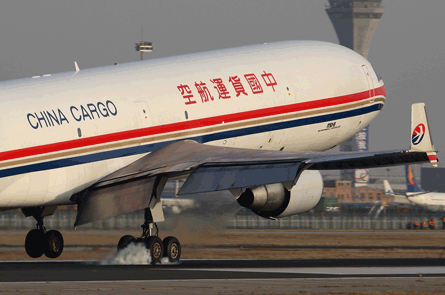IATA's e-freight project, designed to eventually shave $4.9 billion in costs annually across the air cargo supply chain, took a major step forward recently when the first Chinese airport signed up to the initiative. E-freight is one of IATA's Simplifying the Business projects and aims to take the paper out of air cargo.
On 27 May Tianjin's Binhai International Airport became the country's first airport to implement the international e-freight standard. At the same time China Cargo Airlines became the first Chinese carrier to accept an international shipment using the e-freight standard.
 |
|---|
© Bastian DingChina Cargo Airlines has become the first Chinese carrier to use the e-freight standard |
"2010 is a critical year to apply the mandate for e-freight, making sure the standard of e-freight is being adopted worldwide," says Aleks Popovich, IATA's senior vice-president industry distribution & financial services. "We have a target of 44 countries by the end of this year and China is one of them." The adoption of the standard is the first phase of e-freight, he explains.
 | |
|---|---|
"The focus is all about building the route network...the next step is about building volumes"Aleks PopovichSenior vice-president industry distribution & financial services, IATA | |
Potential annual savings from e-freight |
Facilitated by IATA, the project is an industry-wide initiative involving carriers, freight forwarders, ground handlers, shippers and customs authorities. E-freight will eliminate the need to send 20 core paper documents with air cargo shipments, hence streamlining processes, improving speed and reliability and cutting costs.
With e-freight implemented in China, there will be time savings for the transportation and availability of goods by up to 24 hours due to the electronic clearance and paper free process, says IATA.
The aim is to build on the success at Tianjin Airport and implement e-freight in more airports in China, enhancing the competitiveness of China. In addition to the international e-freight programme, there are plans to implement domestic e-freight at six different locations in China in June. China's eight major domestic carriers are participating in the domestic e-freight program.
| IATA e-freight countries Australia, Canada, China, Denmark, Dubai, Egypt, Finland, France, Germany, Hong Kong, Iceland, Japan, Luxembourg, Malaysia, Mauritius, Netherlands, New Zealand, Norway, Singapore, South Korea, Spain, Sweden, Switzerland, Taiwan, UK, USA. |
"In 2011 the target will be to add more and more airports," says Popovich. There are currently 54 major airports worldwide, such as Chicago O'Hare and New York JF Kennedy, using the e-freight standard.
Source: Flight Daily News
















